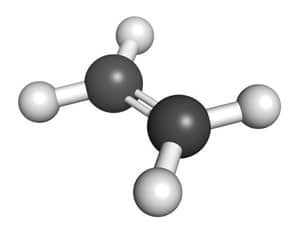
How It’s Used
Ethylene (aka ethene, acetene, bicarburretted hydrogen) is a colorless, noncorrosive, nonirritating, and extremely flammable gas with a slightly sweet odor. The compound is primarily used as a reactive monomer (chemical building block) to make polyethylene and as an intermediate in the production of other organic compounds, such as ethylene dichloride and ethylene oxide. Products produced from ethylene are used to make chemicals and plastics utilized in other industrial processes, and in consumer products such as detergents and automotive antifreeze.
Ethylene exists naturally in the environment and is produced by plants as part of their life cycle and the ripening process. As such, it can be used to control fruit ripening. Historically, it was employed as an anesthetic agent. The compound is utilized as oxy-fuel gas in metal cutting, welding and high velocity thermal spraying.
Occupational Health/Toxicology
Since it is normally present in its gas phase, inhalation is the primary route of ethylene exposure. No risk to human health has been identified from occupational exposure or exposure of the general public to atmospheric levels of ethylene. However, excessive exposure by inhalation may cause headache, dizziness, anesthesia, drowsiness, unconsciousness, or other central nervous system effects. In confined or poorly ventilated areas, the gas can accumulate and result in unconsciousness due to displacement of oxygen.
Exposure to extremely high concentrations of ethylene (20%) can cause anesthetic effects.
Full record on ethylene from Hazardous Substances Data Bank (HSDB), a database provided by the US National Library of Medicine.
The ethylene entry from NIOSH’s version of the International Chemical Safety Cards.
Monitoring Instrumentation
Check out Interscan’s full line of ethylene gas detection/gas monitoring instrumentation.
